There's more than just one Pride flag that you might see waving in the air at the next LGBTQ Pride parade in your city this month.
Today, there are flags for many different identities along the LGBTQ+ spectrum.
The story behind the rainbow Pride flag
The iconic rainbow flag is the universal symbol for LGBTQ Pride today, but it wasn't always.
Until the late 1970's, the pink triangle was the symbol for the gay movement, despite its dark history. According to the United States Holocaust Memorial Museum, the inverted triangle was originally used as an identifier for gay men in Nazi concentration camps during World War II. It placed a stigma on gay prisoners, similar to how the Star of David was used against Jewish people.
More From NBCLX
Why This Professor Thinks Pride is Now ‘A Corporate Food Court'
Black LGBTQ Youth Face Extra Challenges This Pride Month
The triangle, however, was reclaimed by the LGBTQ community and used as a symbol of power decades later.
But many people, including Gilbert Baker, wanted a symbol for the community that was innately positive — thus the birth of the rainbow flag.

According to the Gilbert Baker Foundation, Baker designed and created the first rainbow flag in 1978. Baker was a vexillographer, or flag maker, for more than 40 years. He passed away in 2017.
The original rainbow flag had 8 colors: pink, red, orange, yellow, green, turquoise, blue and violet. Each color on the Pride flag represented something significant: sex, life, healing, sunlight, nature, magic, serenity and spirit.
But the flag has changed over time.
After the assassination of gay San Francisco City Supervisor Harvey Milk in November 1978, demand for the flag increased and there was a shortage of pink fabric. To keep up, the Paramount Flag Company, where Baker worked, dropped the hot pink stripe.
According to the GLBT Historical Society Museum and Archives, the rainbow flag was modified again in 1979 because the middle stripe was obscured when the flag hung on lamp posts. Baker's way to fix the problem was to create a flag with an even number of stripes — dropping another color, turquoise. That change created the six-stripe version of the flag that we all know today.
A few different flags within the LGBTQ+ community
But the rainbow flag is not the only flag that represents LGBTQ+ folks.
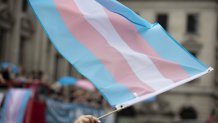
For example, the transgender flag was created in 1999 by trans woman Monica Helms. It has three colors: blue, pink and white. The blue stripe represents boys, the pink represents girls and the white is for people who are transitioning or are gender-neutral.
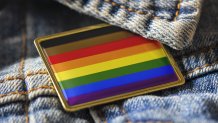
Philadelphia's People of Color Inclusive flag added black and brown stripes to the top of rainbow flag in 2017. The addition was intended to give representation to people of color within the LGBTQ community.
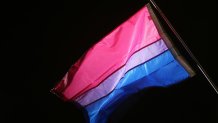
The bisexual flag has pink, blue and lavender stripes that represent same-sex attraction, opposite-sex attraction and attraction to both sexes.
There have been multiple designs of a lesbian pride flag, but the version created by artist Emily Gwen is the most prominent online. In a tweet embedded above, Gwen explains that the stripes on their version represent gender non-conformity, independence, unique relationships to womanhood, serenity and peace, love and sex and feminity. Other versions by different designers have featured a lipstick print and a two-sided axe known as a labrys.
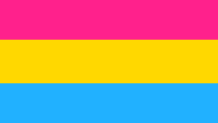
According to the U.K.-based Gay Times, the pansexual pride flag was created in 2010 by the artist Jasper. There are different interpretations of the colors' meanings: some say the magenta, yellow and cyan represent attraction to male-identifying, female-identifying and nonbinary people, respectively. Others say the stripes represent men, women and nonbinary people themselves.
"The pan flag is defined by the people who identify with it, not just what I chose at the point of creation," Jasper said in a Twitter thread on the flag's origins.
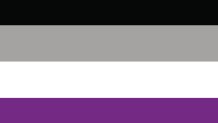
According to OutRight Action International, the asexual pride flag was designed in 2010 and features black, gray, white and purple stripes. The top three stripes represent sexuality, asexuality, and the gray area in between, while the purple stripe represents community.
This intersex pride flag was created by Morgan Carpenter, head of Intersex Human Rights Australia. It features a purple circle on a yellow background, with the circle representing completeness and "the right to be who and how we want to be," Carpenter wrote on IHRA's website.
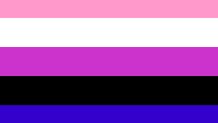
According to OutRight International, the genderfluid pride flag has a pink stripe representing femininity, blue representing masculinity, purple for masculinity and femininity, black for a lack of gender, and white for all genders.
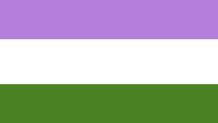
The genderqueer flag was created by Marilyn Roxie and contains lavender, white, and green stripes. The lavender stripe represents androgyny and queerness, the white represents agender identity, and the green represents nonbinary people, according to Roxie's website.
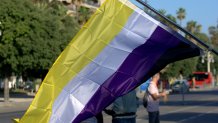
According to the Grand Rapids Pride Center, the nonbinary flag's yellow stripe represents people with a gender identity outside the male-female binary, while the white stripe is for people who identify as multiple genders. The purple represents a mixture of male and female, and the black stripe represents people who identify as not having a gender.
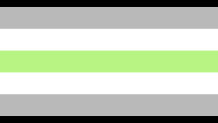
There are seven stripes on the agender pride flag, created by Salem X in 2014. The black and white stripes on the flag represent the absence of gender, the gray represents people who are semi-genderless, and the green represents nonbinary genders.
There are also several other flags that represent people who identify as demisexual, aromantic and polyamorous.
Each flag represents the various needs and experiences of these communities, and as the LGBTQ+ movement continues to grow, so may the number of flags.

